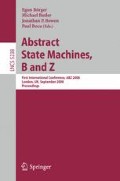Abstract
As part of our work on the formal analysis of object-oriented models, we turn to systems where many autonomous individuals interact to give rise to complex collective behaviour. We adapt our ZOO [1,2] structuring and apply it to a case study based on a published model of part of the immune system [3]. The formalisation calls for a bottom-up solution with no central control over individual units, and includes an approach to represent feedback channels enabling broadcast communication between individuals and across levels.
Access this chapter
Tax calculation will be finalised at checkout
Purchases are for personal use only
Preview
Unable to display preview. Download preview PDF.
References
Amálio, N., Polack, F., Stepney, S.: An object-oriented structuring for Z based on views. In: Treharne, H., King, S., C. Henson, M., Schneider, S. (eds.) ZB 2005. LNCS, vol. 3455, pp. 262–278. Springer, Heidelberg (2005)
Amálio, N.: Generative frameworks for rigorous model-driven development. Ph.D. thesis, Dept. Comp. Science, Univ. of York (2007)
Kam, N., Harel, D., Cohen, I.R.: Modeling biological reactivity: Statecharts vs. boolean logic. In: Proc. Int. Conf. on Systems Biology (ICSB 2001) (2001)
Booch, G., Rumbaugh, J., Jacobson, I.: The Unified Modeling Language User Guide. Addison-Wesley, Reading (1999)
Gamma, E., Helm, R., Johnson, R., Vlissides, J.: Design Patterns: Elements of Resusable Object-Oriented Software. Professional Computing. Addison-Wesley, Reading (1995)
Larman, C.: Applying UML and patterns: an introduction to object-oriented analysis and design (1998)
Kam, N., Harel, D., Cohen, I.R.: The immune system as a reactive system: Modeling T cell activation with statecharts. In: VLFM 2001 (2001)
Kaufman, M., Andris, F., Leo, O.: A logical analysis of T cell activation and anergy. Proc. Natl. Acad. Sci. USA 96(7) (1999)
Harel, D.: Statecharts: A visual formalism for complex systems. Science of Computer Programming 8, 231–274 (1987)
Woodcock, J., Davies, J.: Using Z: Specification, Refinement, and Proof (1996)
Amálio, N., Polack, F., Zhang, J.: Zoo specification of T-cell statecharts (2008), http://www-users.cs.york.ac.uk/~fiona/PUBS/zoo-tcell-statecharts.pdf
Amálio, N., Stepney, S., Polack, F.: Formal Proof from UML Models. In: Davies, J., Schulte, W., Barnett, M. (eds.) ICFEM 2004. LNCS, vol. 3308, pp. 418–433. Springer, Heidelberg (2004)
Saaltink, M.: The Z/EVES system. In: Bowen, J., Hinchey, M. (eds.) ZUM 1997. LNCS, vol. 1212, pp. 72–85. Springer, Heidelberg (1997)
Zhang, J.: Extending an approach to formalize diagrammatic model: Analysis of Harel’s T cell model. Master’s thesis, Dept. Comp. Science, Univ. of York (2006)
Amálio, N., Stepney, S., Polack, F.: Modular UML semantics: Interpretations in Z based on templates and generics. In: Van, H.D., Liu, Z. (eds.) FACS 2003 Int. Workshop, vol. 284, pp. 81–100. UNU/IIST Technical Report (2003)
Borgida, A., Mylopoulos, J., Reiter, R.: On the frame problem in procedure specifications. IEEE Trans. on Softw. Eng. 21(10), 785–798 (1995)
Amálio, N., Stepney, S., Polack, F.: A formal template language enabling meta-proof. In: Misra, J., Nipkow, T., Sekerinski, E. (eds.) FM 2006. LNCS, vol. 4085, pp. 252–267. Springer, Heidelberg (2006)
Stepney, S., Polack, F.A.C., Turner, H.R.: Engineering emergence. In: ICECCS 2006, pp. 89–97. IEEE Computer Society, Los Alamitos (2006)
Liu, J., Tsui, K.: Toward nature-inspired computing. Commun. ACM 49(10), 59–64 (2006)
Author information
Authors and Affiliations
Editor information
Rights and permissions
Copyright information
© 2008 Springer-Verlag Berlin Heidelberg
About this paper
Cite this paper
Amálio, N., Polack, F., Zhang, J. (2008). Autonomous Objects and Bottom-Up Composition in ZOO Applied to a Case Study of Biological Reactivity. In: Börger, E., Butler, M., Bowen, J.P., Boca, P. (eds) Abstract State Machines, B and Z. ABZ 2008. Lecture Notes in Computer Science, vol 5238. Springer, Berlin, Heidelberg. https://doi.org/10.1007/978-3-540-87603-8_25
Download citation
DOI: https://doi.org/10.1007/978-3-540-87603-8_25
Publisher Name: Springer, Berlin, Heidelberg
Print ISBN: 978-3-540-87602-1
Online ISBN: 978-3-540-87603-8
eBook Packages: Computer ScienceComputer Science (R0)

